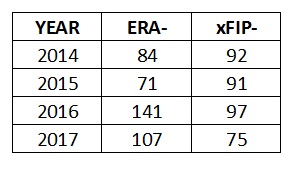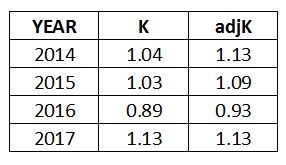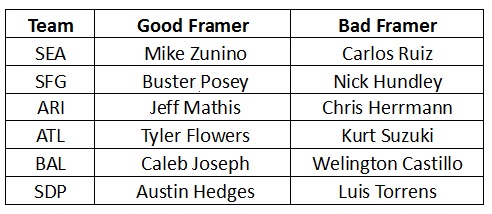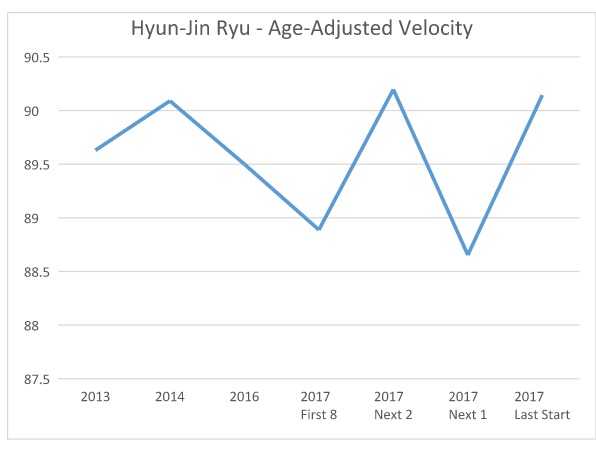Risers and Fallers: Volume 5
![]()
I’m excited to be back for another week of Risers & Fallers! Each week, I’ll break down a handful of players using advanced metrics, insights from my scouting background, and my DFS projection system THE BAT (available in the RotoGrinders Marketplace), which consistently beat Vegas lines last year.
I’ll examine guys whose stock is going up, guys whose stock is going down, guys who are perpetually underpriced or overpriced, guys who are worth paying a premium for, or guys who are just interesting and warrant some analysis on. If you guys have any suggestions for who you’d like to see in future articles, feel free to let me know.
Rising… And Not Fraudulently
Sonny Gray, SP, Oakland A’s
Sonny Gray is an enigma… in a lot of different ways. Ask 10 DFS players what they think of Sonny Gray, and you’re bound to get 10 different answers. The funniest part is that Gray’s peripherals have barely changed over the course of his major league career, but the perception at any given point in time has been wildly different. THE BAT has been liking Gray in quite a few matchups lately, and so I initially set out to write a “Sonny Gray is back” piece, but that’s just not really accurate.
Gray burst onto the scene midway through 2013, dominating over 10 games and never looking back. He continued in 2014 and seemingly got even better in 2015, posting a 2.73 ERA and garnering Cy Young talk. The problem was that most of the savvy DFS players weren’t buying it. Gray quickly developed a reputation as a “fraud” thanks to an xFIP that was nearly a point higher than his ERA and a pedestrian 7.3 K/9. More importantly, though, Gray was priced liked a legitimate ace and was treated like one by many in the community, who continued to roster him at the high prices yet never got burned by the kind of regression we all expected. This left a bad taste in quite a few mouths, but they were sated in 2016 when Gray dealt with injuries and posted a 5.69 ERA. This season, Gray’s ERA is nothing special (4.44), but there is plenty of reason to like him. Before we get into that, though, take a look at Gray’s ERA- and xFIP- for each full year of his career (these are his ERA and xFIP scaled to league average, where 100 is average, under 100 is good, and over 100 is bad):

Gray’s ERA has fluctuated wildly from year-to-year, but his xFIP has remained remarkably steady— through his overrated years, through his “I told you he was a fraud!” years, and up until this year when it has actually improved.
Would the real Sonny Gray please stand up?
Eno Sarris wrote an interesting piece at FanGraphs recently that talks about how much Gray tinkers with his pitches and grips, how he throws three or four different breaking balls, and basically just how tough it is to get a good handle on him—adding to the enigma.

If I look at Gray’s grades in my “stuff” system, though, the takeaway is the same as from xFIP—despite the tinkering, despite the wide swings in results, this guy just hasn’t changed much. The overall quality of his stuff was basically unchanged between 2015 and 2016 (when we saw the biggest swing in results despite an xFIP that remained stable).
The only real issue you might be able to point to with Gray is the home runs (which doesn’t factor into xFIP). That’s a big reason why his ERA was so inflated last year. But a 17.5% HR/FB indicates a lot of bad luck, particularly when it was around 9% for his career prior to 2016. This year those problems have remained to an extent (14.3% HR/FB), but three of his five home runs came in his first start back from the DL against Minnesota, which makes it fairly easy to give him a pass, particularly when his strikeout rate is a career high.
So why is the strikeout rate up? Part of it is that he’s shifted a bit more of his focus onto his offspeed stuff, throwing his change-up and breaking balls a combined 46% of the time this year—up from 39% last year and 40% in 2016. A good offspeed pitch, of course, is much better for strikeouts than a fastball is, assuming you’re not using it so much that the hitter can sit on it. And his off-speed stuff is really good, the breaking balls in particular.
The other reason, according to THE BAT, is that he’s always been a pretty good strikeout pitcher—his previous rates have just been deflated by bad context. Here are his K rates for the past four seasons, both adjusted for context (adjK) and unadjusted (K) and scaled to league average (1.00):

For three straight years, Gray appears to have deserved more strikeouts than he actually got. The reasons why are threefold:
1) He played in a home park that suppresses strikeouts
2) He unluckily faced a collection of hitters with a below-average strikeout rate (in 2014 and 2015)
3) He threw to a bad group of pitching-framing catchers (especially in 2014)
The last one is particularly notable. In 2014, Gray was throwing mostly to John Jaso, back before major league teams decided he should never be allowed to catch another game again. In 2015 and 2016, he threw mostly to Stephen Vogt and Josh Phegley – both below average.
When you strip all that away, instead of projecting Gray using three years of average strikeouts and a few starts from this year of being good, you wind up including two years of good strikeouts plus this year, and all of sudden Sonny Gray looks like a guy that can get some Ks.
Fraudulency is all about context. DFS players were (mostly) right to call Gray a fraud in 2015 when he cost over $10,000 on DraftKings each and every start (and to clarify, I was definitely one of them). Flash forward to 2017, though, and he’s striking more guys out and has cost no more than $8,800, dipping down to close $7,000 for a number of starts. Gray is not back to being the ace he was in 2015, because he wasn’t an ace in 2015. But he was a good pitcher, and good pitchers have value as SP2s when they now only cost $7,500.
Gray will still have some bad context to deal with. He continues to throw to two below-average pitch-framers (though neither are as bad as Jaso in 2014), a park that suppresses strikeouts (though it doesn’t suppress them quite as much as it did a couple years ago), and a bad defense (no sugar-coating that one), but when you strip all of this context away and just focus on Gray’s skills, he’s a good pitcher. In the right matchups, with the right context, I’ll be playing Gray going forward (and you should too).
What I’m really excited about, though, is the trade deadline. The Houston Astros are rumored to have interest. Should he be traded, all of those contextual things currently working against him will flip in the other direction, and he could start to resemble an actual ace if that happens.
Rising and Falling… Depending on the Day
Any Starting Pitcher on the Mariners, Giants, Diamondbacks, Braves, Orioles, or Padres
Catcher pitch-framing is something I talk about a lot, almost to the point where I may be assuming everyone knows not only what it is, but who is good at it, who is bad at it, and what the practical difference is. This is a lot to assume, so I wanted to spend a little time today going over pitch-framing and what to look out for.
Pitch framing has only become mainstream in the past three or four years, but it’s something that’s been going on inside the game of baseball for decades. Pitch framing, in its simplest terms, is the ability of a catcher to receive a pitch and make it look to the umpire like a strike.
So how does a catcher frame a pitch? Quick, quiet hands are key. They don’t want to catch the ball outside the zone and then yank it into the zone. It needs to be subtle with as little perceived movement as possible. Catching it near the center of the body also helps make it look more like a strike than if the arm is outstretched bringing it in. There was a great article by my former Baseball Prospectus colleague, Ben Lindbergh, at Grantland a few years ago.
Framing is a skill catchers can work on and develop… to the point even that the impact of framing has diminished over the past couple years as, league-wide, catchers have realized just how important it is and have emphasized it in their practice. After all, framing is a relative skill. If everyone can frame a pitch well and everyone is getting their pitcher extra strikes, then nobody really is. League-wide there will be more strikes and fewer balls, but no individual catcher would have any advantage over another. We’re definitely far from that point still, but we’re closer than we were a couple years ago. In another few years catcher framing may well become something of an afterthought. For now, though, there is still plenty of edge to be gained by focusing on catcher pitch-framing, and the biggest edges come for a few teams.
The following six teams have the biggest difference between the framing skills of their starting and backup catchers.

For each of these teams, the difference in framing skills between the two catchers is at least 0.20 points of ERA. That means that if James Paxton is projected for a 3.80 ERA in a matchup with Mike Zunino as his catcher, if Zunino gets scratched and replaced with Carlos Ruiz, he would then project for an ERA over 4.00. It’s not a massive difference, not enough to take a guy from being a good play to a bad one, but it could certainly be enough to sway your decision between going with one pitcher or another. DFS is a game of edges, and pitch-framing is one way to gain an edge. Pile it up with several other edges (weather, umpires, defense, whatever) and you find yourself at a distinct advantage over your competition.
(I should also point out that the Diamondbacks actually have three catchers, and Chris Iannetta is in between Mathis and Hermann. There’s still a pretty big gap between Mathis and Iannetta, so Mathis is definitely the guy you want catching if you’re trying to play Robbie Ray or Zack Greinke.)
One final thing to keep in mind with pitch-framing: if we’re looking at a pitcher’s stats (even his peripheral stats like strikeouts and walks that most analysts tend to attribute solely to the pitcher since they are very “stable”), it’s important to keep in mind the mix of catchers he’s thrown to.

For instance, Zack Greinke has thrown all 14 of his starts this year to Mathis. He has received the most benefit from pitch-framing of any non-Dodger starting pitcher in all of baseball this year (the Dodgers, of course, throw all their games to Yasmani Grandal and Austin Barnes – the two best pitch-framers in baseball). That means that a significant chunk of his 10.4 K/9 is attributable to framing and not necessarily to anything he himself is doing, and if he were to ever throw to Iannetta or Hermann we would expect a bigger drop-off than we would for, say, Patrick Corbin. While Greinke has received elite framing support, Corbin (despite pitching on the same team) has received below-average framing support. Corbin has thrown to Mathis just twice, Hermann four times, and Iannetta ten times. While Grienke would receive no additional benefit throwing to Mathis, since his numbers already reflect throwing to him, Corbin would get a significant boost throwing to Mathis since his do not.
Still Rising… But It Was Bumpy For a Second There
Hyun-Jin Ryu, SP, Los Angeles Dodgers
Last week I wrote about Ryu and how his velocity over his previous two starts had basically been a career high once you account for aging effects. No sooner had I written that, however, Ryu goes out and throws a start where his velocity plummets nearly 3-mph. Great. Analytical shelf-life of like 20 minutes. Ryu took one more start since then, though, and his velocity was right back to where it was in those really good starts. Here’s an updated version of the chart I showed you last week that highlights the ups-and-downs of Ryu’s velocity:

That start against the Reds definitely sticks out and should cause a little concern going forward, but that the velocity rebounded immediately is a good sign. I’ll want to watch how Ryu’s velocity trends over his next couple starts, but there still seems to be plenty of reason to think he’s working with the best age-adjusted velocity of his career and could be in for some good starts going forward.